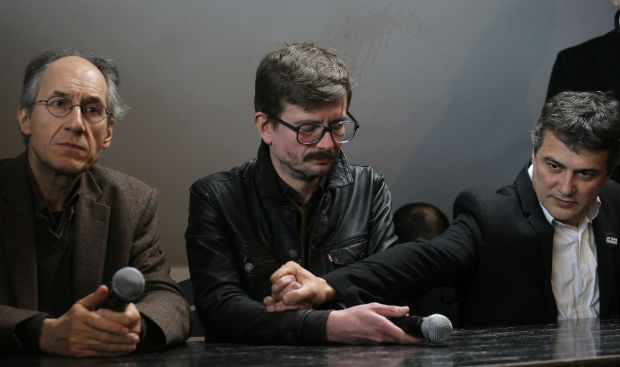Charlie Hebdo draws more threats with new Muhammad cartoons

The new chief editor of French satirical magazine Charlie Hebdo, Gerard Biard, left, and columnist Patrick Pelloux, right, comfort Cartoonist Renald Luzier, known as Luz during a press conference in Paris, France, Tuesday, Jan. 13, 2015. Twelve people died when two masked gunmen attacked the newspaper’s offices on Jan. 7, including much of the editorial staff and two police. AP
Satirical newspaper Charlie Hebdo has received new warnings and threats from Muslims as it prepares to release a new edition with more cartoons of their Prophet Muhammad.
The Dar al-Ifta, Egypt’s top Islamic authority, called the most recent issue an “unjustified provocation” for millions of Muslims who respect and love their prophet and warned the cartoon would likely spark a new wave of hatred.
Dar al-Ifta issued its warning as criticism and threats immediately appeared on militant websites, with calls for more strikes against the newspaper, according to the SITE Intelligence Group, a U.S.-based terrorism monitor.
The latest issue shows a caricature of a tearful Muhammad bearing the slogan “Je suis Charlie” (“I am Charlie”). He is shown under the title “All is forgiven.”
It will be released a week after Islamists attacked the paper’s offices in Paris and murdered 10 journalists and two policemen. The ensuing violence led to the deaths of five other people, including three Islamist gunmen.
Article continues after this advertisementThe latest edition maintained the intentionally offensive tone that made the newspaper famous in France. The first two pages included drawings by the slain cartoonists: One showed a much-loved late French nun talking about oral sex; another showed Muslim, Christian and Jewish leaders dividing up the world.
Article continues after this advertisementThe lead editorial laid out a vigorous defense of secularism, and of the newspaper’s right to lampoon religions and hold their leaders accountable — and ended with a critique of the pope.
But most of the controversy centered on the cover and its depiction of the Prophet Muhammad.
It ran a double-page spread illustrating Sunday’s march in Paris that drew more than a million people to condemn terrorism, claiming that the turnout was larger “than for Mass.”
“For the past week, Charlie, an atheist newspaper, has achieved more miracles than all the saints and prophets combined,” it said in the lead editorial. “The one we are most proud of is that you have in your hands the newspaper that we always made.”
Charlie Hebdo planned an unprecedented print run of 3 million copies.
Surviving staff members are now using the offices of the Liberation newspaper, which has loaned out space.
Zineb El Rhazoui, a journalist with the weekly, said the cover meant the journalists are forgiving the extremists for the attack.
Cartoonist Renald “Luz” Luzier, who drew the cover image under the pen name “Luz,” said it represents “just a little guy who’s crying.”
Then he added, unapologetically: “Yes, it is Muhammad.”
Speaking at a news conference in Paris on Tuesday at which he repeatedly broke down crying, Luzier described weeping after he drew the picture.
Around the world, news organizations took different approaches to illustrating stories about the Charlie Hebdo cover. In the United States, a CBS program and The New York Post ran images of the cover, while the ABC network didn’t. The New York Times also didn’t publish it, but included a link to it. CNN didn’t show the cover online or on the air. The Associated Press had not run previous Charlie Hebdo cartoons showing Muhammad, and declined to run the latest one as well, based on its policy to avoid images designed to provoke on the basis of religion.
In Europe, Spain’s leading daily newspapers published the image online and the state broadcaster showed it on news bulletins. In Britain, The Times of London, the Guardian and the Independent went with the image, while The Daily Telegraph didn’t. The BBC showed the new cover on news programs. Germany’s Sueddeutsche Zeitung, Der Spiegel and Frankfurter Allgemeine Zeitung all used it on their websites.
RELATED STORIES
German paper that ran Charlie Hebdo cartoons firebombed
Defiant Charlie Hebdo puts Muhammad on first cover since attack